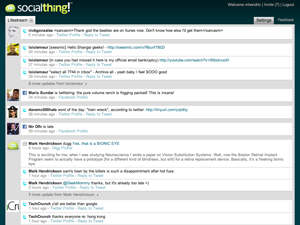Update: Head over to InviteShare to help others get into Socialthing! Each user is given 10 invites to hand out.
There are a bazillion social network aggregators out there (Mike attempted to round up some of the most notable ones here). FriendFeed is the most visible of them all for two main reasons: it was founded a group of ex-Googlers and, as a consequence, benefits from a clean and easy-to-use design.
But FriendFeed’s going to have some serious competition from a TechStars startup called Socialthing!, which makes it even easier to get an overview of what your friends are doing on the web.
Socialthing! officially goes into private beta today and will let in the first 1,000 TechCrunch readers who use the invitation code “TechCrunch” to sign up (you’ll probably have to wait a few days to get your account, however). The service primarily differs from FriendFeed in the way it determines which of your friends to track. While FriendFeed actually requires users to create their own list of friends on FriendFeed, Socialthing! realizes you probably don’t want to create yet another list of your friends. So instead of asking you to do more work, it automatically detects who your friends are on the social services to which you belong.
The distinction may sound inconsequential but Socialthing!’s method actually makes things a lot easier, both for initial set up and for longer term maintenance. When you sign up for Socialthing!, you only have to provide it with your credentials to sites like Facebook and Pownce. And as time goes by, you don’t have to worry about setting up new friends on the service because it will automatically know that you’ve become friends with people elsewhere. In contrast, FriendFeed requires you to both explicitly designate friends during the initial configuration (either one-by-one or through Facebook/Gmail importing) and manually add new friends over time.
Another benefit Socialthing! has over FriendFeed is its focus on allowing users to send data back to social services (if you want to respond to someone’s tweet, for example, you can do so directly from Socialthing!). On the other hand, FriendFeed is all about reading data from services but not about writing it back.
While FriendFeed generally takes more effort, its approach does have unique advantages. You can follow friends of friends on FriendFeed and see updates from services that you don’t personally use, all because FriendFeed users have more independently-defined presences. FriendFeed also supports a wider range of services than Socialthing! (28 vs. 11, although Facebook updates are noticeably lacking from FriendFeed). Time, however, should narrow the gap.
In the end, whether FriendFeed succeeds more than Socialthing! will depend on whether people are looking for another community or just a way to easily track their existing ones. I suspect the latter will be the case.

